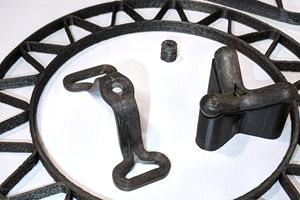CW Top Shops: Meaningful data for composites fabricators
The amount of data produced by manufacturing facilities is increasing exponentially. CW Top Shops' inaugural benchmarking survey helps contextualize some of that data.
I have an uncle who earned his degree in electrical engineering in the 1960s and went on to enjoy a profitable career as an engineer and then data analyst. He is, by nature, highly data oriented and enjoys making and maintaining databases of all types — golf scores, bowling scores, batting averages, etc.
The most famous database my uncle developed was one that he maintained over a period of 15 years, 1985-1999. In this dataset he recorded found coins. That is, every time he found a coin in a public place, he noted the denomination of the coin, the year it was minted, where it was found (city, state, country) and the date and time at which it was found.
He doggedly recorded this information in an Excel spreadsheet and then, each year, issued to everyone in our family a report of his findings, which used a variety of pivot tables to slice and dice the data to reveal interesting observations about the coins he’d discovered. As the years went on, my uncle would compare coin data from the current year to previous years, revealing trends and even more hidden informational gems.
I looked forward to my uncle’s coin report each year and admired the systematic determination its creation required. I was also struck by a couple of things about my uncle’s coin database. First, he found a lot of coins — more than 17,000 over that 15 years. I figured that his desire to build a database of found coins likely made my uncle uncommonly aware of coins to be found. Second, although his annual reports were intensely interesting, I often found myself wondering what the data meant. My uncle poured a great deal of time and energy into developing and maintaining this database, but to what end? What is the value of such data?
If you are a manufacturer of composite parts and structures, this question of the value of data is not a trivial one. Any composites manufacturing operation generates an immense amount of data that has has various levels of potential utility. On a typical manufacturing floor, the most obvious display of data surrounds operations efficiency, quality control and safety. Often, bulletin boards, television monitors and other visual devices are used to signal to workers and supervisors how well certain manufacturing processes are conforming to the standard.
Such data, however, are baseline only. There is additional information — sometimes unseen — surrounding material quality, material expiration, material waste rate, machine performance, equipment utilization, order lead time, delivery performance, customer reject rate, customer retention rate and much more. The question is, what does it mean? How does one facility put all of this data into context?
That is the question that the CW Top Shops survey attempts to answer. Launched earlier this year, the CW Top Shops survey was sent to thousands of composites fabricators, asking them to provide metrics about their operations, ranging from facility size and markets served to machine utilization and profit margin. The value of the CW Top Shops data is simple: It allows you to compare your composites manufacturing operations to other composites manufacturing operations. It helps you see strengths and weaknesses — where you excel and where you can improve.
We received 110 responses to the survey this year, and you will find on p. 20 of this issue samples of some of the data we received. You will also find the list of 31 companies that scored highest in the survey and earned the CW Top Shop award. If you participated in the 2019 survey, you received a customized report that showed you your facility’s data and compared it to other survey respondents. If you did not participate this year, you can still purchase the CW Top Shops report, which includes all respondent data. You can also look forward to the CW Top Shops survey returning in 2020.
As you very likely know, the amount of data emerging from your manufacturing operations is increasing exponentially. It is no longer acceptable to simply gather and store that data. One of your jobs as a fabricator will be to organize it, put it in context and give it meaning. We hope that CW Top Shops becomes a valuable tool in that effort.
Related Content
High-performance, high-detail continuous 3D-printed carbon fiber parts
Since 2014, Mantis Composites has built its customer and R&D capabilities specifically toward design, printing and postprocessing of highly engineered aerospace and defense parts.
Read MoreLockheed Martin expands development, production of ultra-high temp CMCs with facility expansion
Targeting current and future needs in hypersonic and aeronautics applications, Lockheed Martin Skunk Works’ Allcomp team is increasing and digitizing its capabilities in ceramic matrix composite (CMC) materials and parts fabrication.
Read MoreMaterials & Processes: Fibers for composites
The structural properties of composite materials are derived primarily from the fiber reinforcement. Fiber types, their manufacture, their uses and the end-market applications in which they find most use are described.
Read MorePlant tour: Renegade Materials Corp., Miamisburg, Ohio, U.S.
Renegade Materials is known for high-performance prepregs for aerospace applications. Following its acquisition by Teijin in 2019, the company has expanded capacity and R&D efforts on a range of aerospace-targeted materials.
Read MoreRead Next
CW’s 2024 Top Shops survey offers new approach to benchmarking
Respondents that complete the survey by April 30, 2024, have the chance to be recognized as an honoree.
Read MoreComposites end markets: Energy (2024)
Composites are used widely in oil/gas, wind and other renewable energy applications. Despite market challenges, growth potential and innovation for composites continue.
Read MoreFrom the CW Archives: The tale of the thermoplastic cryotank
In 2006, guest columnist Bob Hartunian related the story of his efforts two decades prior, while at McDonnell Douglas, to develop a thermoplastic composite crytank for hydrogen storage. He learned a lot of lessons.
Read More












.jpg;maxWidth=300;quality=90)









